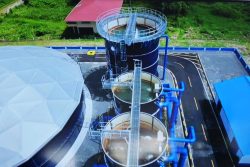ROBERT, La (Reuters) – BP Plc engineers using undersea robots maneuvered a massive metal chamber to fit over a gushing ruptured oil well in the Gulf of Mexico yesterday in their best chance yet to contain a leak that threatens an environmental catastrophe on US shores.
The four-story structure, the best short-term hope of controlling the spewing crude, was lowered to the seabed almost one mile (1.6 km) below the surface in an attempt to funnel the escaping oil to a surface tanker.
BP, which faces major financial losses from the spill, suffered a further blow when ratings agency Standard & Poor’s lowered its outlook on the British oil giant to negative from stable.
It is under pressure from the Obama administration to limit the damage from what could be the worst oil spill in US history. BP has said it will pay all legitimate costs, a bill that is likely to run into the billions of dollars.
BP officials hope the container will begin funneling oil from the leak next week. Workers will spend the next three to four days making the connections to pump crude to the surface.
The device has not been tried at that depth, where engineers guiding remotely operated vehicles battle darkness, currents and intense undersea pressure. BP Chief Executive Tony Hayward warned there was no certainty of success.
“The pressures and temperatures are very different here, so we cannot be confident that it will work,” Hayward told CNN.
BP is drilling a relief well to halt the leak — which began after the Deepwater Horizon exploded on April 20, killing 11 crew members — but it could take up to three months to complete. Engineers have also considered pumping heavy fluids into the top of the failed blowout preventer to plug the leaking well in a technique called “top kill.”
They gave up on efforts to close valves on a failed blowout preventer with underwater robots, after trying in vain for two weeks, Doug Suttles, BP’s chief operating officer, said.
Surface containment efforts continue, helped by calm seas. Controlled burns on Thursday removed up to 9,000 barrels (280,000 gallons/1,070,000 litres) of oil, he said.
It “is a very powerful technique and when the weather is good it will continue,” Suttles said.
Forecasts suggest light winds through today, although they are expected shift and come from the south to southwest, which could push the slick toward the Louisiana shore.
About 250 boats deployed protective booms and used dispersants to break up the thick oil yesterday. Crews have laid almost 800,000 feet (240,000 metres) of boom, and spread 267,000 gallons (1 million litres) of chemical dispersant.
On Thursday, after meeting with BP executives in Houston, US Interior Secretary Ken Salazar said the company and its partners made “some very major mistakes.”
Salazar reiterated the US government will issue no new offshore drilling permits until an inter-agency panel gives a safety review to President Barack Obama by May 28. In the meantime, current drilling will continue.
The spill threatens an economic and ecological disaster on tourist beaches, wildlife refuges and fishing grounds in Louisiana, Mississippi, Alabama and Florida. It has forced Obama to rethink plans to open more waters to drilling.
At least 5,000 barrels (210,000 gallons/795,000 litres) have poured into the Gulf each day since the well ruptured.
A sheen of oil has engulfed much of the Chandeleur Islands, barrier islands that are part of Louisiana’s Breton National Wildlife Refuge, the first confirmation of the oil slick hitting land. Some oiled birds have been found in recent days.
The Breton refuge was closed to the public after a silver sheen and emulsified oil reached the shoreline, the US Fish & Wildlife Service said. Altogether, crude from the spill could hit 24 national wildlife refuges.
A Reuters photographer, on a flyover of the coast, saw a band of oil, orange in color and about a mile or two long, running parallel to shore about 17 miles (27 km) south of barrier islands off Mississippi’s mainland.
Numerous black blobs, possibly emulsified tar, were visible just below the surface in shallow water near some marsh coast to the east of the Chandeleur Islands.
US authorities yesterday modified and expanded the boundaries of the area closed to fishing as a result of the spill, and extended restrictions for another 10 days, to May 17. The closed area represents almost 4.5 percent of Gulf of Mexico federal waters, up from slightly less than 3 percent included in the original ban.







